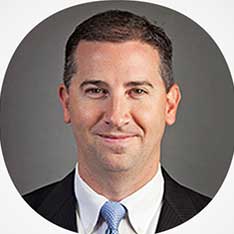Delivering top-of-license community focused pharmacy care in rural Georgia

"My autonomous pharmacy vision is to remove human touch from the dispensing process and to move pharmacy to a zero-harm culture."
On this page:
- The Challenge
- Q&A
- Vital Statistics
- Core Technology
Soon after high school, Chris Newman was hired to work in the pharmacy at John D. Archbold Medical Center in his hometown of Thomasville, Ga. It was an experience that shaped his life and career.
“After pharmacy school, I was inspired to return and make a difference in the community I grew up in,” he said.
Today, as the member of the health system’s executive team responsible for the pharmacy, radiology, lab, materials management, supply chain, sleep and neuro diagnostics departments, he’s giving back in ways that his teenage self could have never imagined.
Q&A
-
Q: What is it about population health that first stirred your passion?
A: After I first returned to the area, pharmacy was known as being "just a phone call away." Nobody knew the pharmacist. They just knew to call this phone number and someone would fix their problems, someone would get them their medications.
In the 15 years since, I’m proud that we've utilized automation to expand the scope of pharmacy and to find ways to have our pharmacists operate at the top of their licenses.
Automation has enabled centralized pharmacy management and allowed us to expand programs, to get into revenue-generating areas of retail, such as long-term care facilities, pure walk-up retail, and even specialty pharmacy. As a result, we’ve increased the influence of our pharmacists across the medication-use process throughout our nine-county rural area. Omnicell has been a core part of our story.
-
Q: What motivated you to start your population health initiatives?
A: It started with managing the health of our 2,500 health system employees. Ours is a self-funded health plan. Pharmacy and HR work together to manage that financial burden.
We have a particular focus on managing the health—and maximizing savings from 340B Program pricing—of employees and dependents with chronic conditions, including diabetes, hypercholesterolemia, high blood pressure, autoimmune conditions, and asthma.
We make sure patients are enrolled in disease management programs. We ensure access to medications. And we make sure patients are compliant so that their long-term care costs are minimized. In turn, employees get their maintenance meds for free.
The resulting improvements in employee health and productivity have more than paid for the program.
From a population health standpoint, one of my goals is to take this disease management model to other mid-to-large employers in the area to influence their care decisions.
-
Q: How have you improved the care experience for specialty pharmacy patients?
A: Previously, oncology and retail pharmacy were managed as separate functions. Due to separate processes, and time spent working with payors and drug manufacturers, patients could wait from 2-3 weeks for their medication, with no human touch in the process.
If you’re dealing with cancer, it can be a life-changing experience. When you think a medication can make a difference in your condition, you can’t be expected to wait two weeks.
To change that, we analyzed the problem, patient by patient, medication by medication, payor by payor.
We learned we didn’t need more resources to manage it. We just needed a different focus.
So, we reallocated the oncology employee to the pharmacy department and concentrated on doing what’s right for the patient—whether that’s finding funding for specific conditions, or convincing third-party payors of our top-of-the-line service, or convincing manufacturers that we should be the ones distributing this product because of our touch with the patient. Now, we’ve closed the gap for wait times to within 48 hours, making a true difference in that patient interaction.
-
Q: What surprised you most about population health?
A: Probably what surprised me the most is the importance of access to care. People have a lot of competing priorities. The easier you make it for them to access healthcare, the more likely they are to get care and to have success with their conditions.
Our retail pharmacy is a prime example. We used to have our employees come into the hospital and go up to the sixth floor to have their prescriptions filled. Our capture rate was about 40%.
Since we opened a first-floor retail pharmacy and added a location across town with drive-through access, our capture rate is above 95%.
To make a difference in population health, care has to be convenient for patients.
-
Q: What pharmacy metrics are most closely watched by the health system’s board?
A: Drug expense. It catches everyone’s eyes. Board members want to know what pharmacy is doing to contain the rising cost of drugs.
To report those results to the board, I'm starting to use Performance Center. Performance Center provides actionable data. We can use it to track savings opportunities and drug inventory optimization initiatives, such as formulary decisions, monitoring inventory turns, and cost sharing between our four hospitals. Seeing inventory use in real time, down to the cabinet level, has a large financial benefit.
Also, with Performance Center, we’ve seen soft cost savings associated drug shortage management. My drug buyer receives actual usage data from Performance Center as she’s placing the daily order, which makes her a more diligent buyer. That’s a big win for us.
-
Q: What’s your personal Autonomous Pharmacy vision?
A: My autonomous pharmacy vision is to remove human touch from the dispensing process and move pharmacy to a zero-harm culture. We've got to find creative ways, using metrics and comparative benchmarks, to develop systems that decrease variability and to decrease the number of human touch points in the dispensing process.
Vital Statistics

Archbold Medical Center
- Staff beds322
- Employees2,500
- Medical Staff160
- Hospital4
- Physician Group1
- Ambulatory Surgery Center2
- Imaging Center1
- Home Health Agency1
- Hospice2
- Skilled Nursing Facility6
- Rural Health Clinic3
- Urgent Care Clinic1
Core Technology
EHR: Cerner
Omnicell Technology:
 Back to Customer Stories
Back to Customer Stories